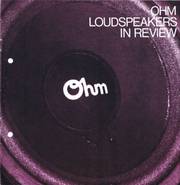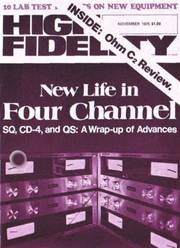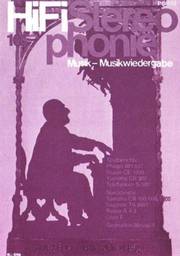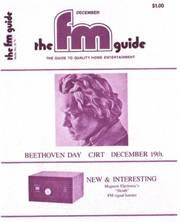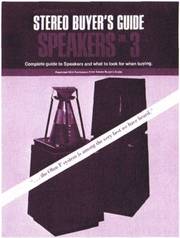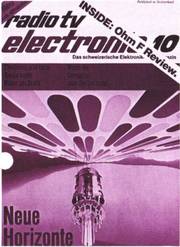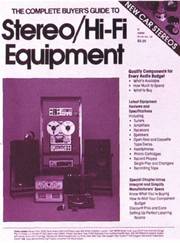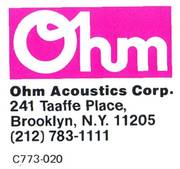Eine OHM Broschüre aus USA mit Test-Nachdrucken
So um 1978 war der "Run" auf die OHM F so gut wie vorbei. Der deutsche Vertrieb tat sich scher und schwerer, die großen und vor allem schweren Boliden noch irgendwo unterzubringen.
Das merkten auch die Amerikaner, die Umsätze gingen weltweit zurück und auch das Abdriften in den konventionellen Lautsprechermarkt brachte nicht mehr die versuchte Wende. Das versuchten zu diesem Zeitpunkt so gut wie alle Firmen, die sich mit dem scheinbar grenzelosen Wachstum verschätzt hatten.
Das war zum Beispiel aucchdie US- Kopfhörer-Firma KOSS und auch die US- Edel-Marke McIntosh. Der ehemalige McIntosh Lautsprecherentwickler Mr. Russell schreibt das gnadenlos auf seiner Webseite. Auch wenn Sie über KOSS in den US-Magazinen recherchieren, werden Sie den Konkurs von KOSS nicht übersehen.
Auch OHM kam nach 1978 ins Schlingern und inzwischen ist von OHM nichts mehr da - außer einem pensionierten Ex-Mitarbeiter, der auf Wunsch noch etwas von den ehemaligen Boliden repariert.
CONTENTS
.
- High Fidelity, November 1976
(OhmC2)................................1 - Hifi Stereophonie, October 1974
(Ohm F)..................................2 - Stereo Review, November 1973
(Ohm F)..................................4 - The FM Guide, December 1976
(Ohm F).................................8 - Stereo Buyer's Guide
(Ohm F)..................................9 - Radio TV Electronics 9 & 10
1975 (Ohm F).........................13 - Canadian Stereo Guide, Winter
1974 (Ohm E).........................18 - The Complete Buyer's Guide to Stereo/Hifi Equipment
January 1977 (Ohm C2,H, F)..20
.
.
Gleich mal eine Anmerkung zu den konventionellen Boxen wie der OHM C2. Diese Boxen konnten bei uns hier in Deutschland nie Fuß recht fassen, dafür gab es vielzu viel Wettbewerb - auch aus Amerika von KLH und Infnity usw..
.
Nov. '76 HIGH FIDELITY
Reprinted from Nov. '76 HIGH FIDELITY.
Ohm's C-2 Bookshelf System Has Bass Galore
The Equipment
Ohm C-2, a bookshelf speaker system, in walnut-finished enclosure. Dimensions: 14" by 9 3/4" by 25" inches. Price: under $250. Warranty: "limited," five years parts and labor. Manufacturer: Ohm Acoustics Corp., 241 Taaffe Place, Brooklyn, N.Y. 11205.
Comment
The days when bookshelf loudspeakers flexed their nonexistent muscles and rattled their drivers in search of those last octaves of bass - and all to no avail - are far behind us. But it still comes as a bit of a shock to find a bookshelf model that, while substantially deprived of room boundary reinforcement, actually can overdo things at the low end. The Ohm C-2 is just such a loudspeaker, and its overrobust bass output fortunately is very easy to tame.
The sound of the C-2 resembles that of a much larger system, in dynamic range as well as bass output. The CBS labs found that it can produce a 300-Hz steady-state tone at 108 dB SPL 1 meter on axis, using an electrical input of 20 dBW (100 watts), without excessive distortion. The onset of distortion is gradual, so that more is present at lower levels than with some other loudspeakers, but this is scarcely audible when music is played. The system does phenomenally well at 80 Hz, reaching 100 dB SPL with distortion quite low.
Pulsed input at 300 Hz gives results entirely consistent with the steady-state behavior: A peak output of 114 1/2 dB is produced from a peak input of 26 dBW (450 watts), with the test amplifier the first to throw in the towel. The average SPL of nearly 86 dB turned out with a 0-dBW (l-watt) input in the range from 250 to 6,000 Hz is indicative of efficiency somewhat above average.
At its nominal rating point the C-2 is a rarity indeed - a real 8ohm speaker. Impedance is higher than 8ohms through most of the mid-range and treble frequencies and approaches 4 ohms only at 20 kHz, a region in which little musical energy is usually present. Two of these speakers in parallel would seem to be a relatively safe load for a typical solid-state amplifier.
Anmerkung : Was soll dieser Kommentar ? 2 Stück parallel schalten ?? Das hatte auch in USA niemand gemacht.
In the anechoic chamber, the average omnidirectional frequency response of the Ohm C-2 is within ±5 dB, re 82 dB SPL, from just below 50 Hz to just beyond 16 kHz, and the region from 1 kHz up is particularly flat.
Tested with one-third-octave bands of pink noise in a normal listening room, the low-frequency output falls away between 30 and 40 Hz-just about where Ohm claims it will. The three-position switch on the back of the unit that controls high-frequency output (marked for 0,-3, -6 dB) is unusually accurate, giving a close approximation of 3 dB per step from about 2 to 18 kHz. High-frequency dispersion will set no records but holds up well to a little more than 30 degrees off axis.
(The manufacturer's setup instructions appear to take this into account in recommending that a pair of speakers used for stereo be angled in slightly and that the listeners be seated well between them.)
Ohm C-2 Loudspeaker Harmonic Distortion
We found no difficulty in setting up a pair of C-2s. The binding posts accept bared wires or spade lugs easily, and the recommended banana plugs best of all.
Located on a shelf and at least two feet from the corners of the room, the speakers produce a sound that is clear and well detailed and-if you
want it that way-loud. Transient response is crisp except for a slight tubbiness in the lower bass. For classical music we preferred to turn down the bass just a bit, which works very well since the "excess" bass contour is a good match for the usual capabilities of amplifier tone controls. (Using a rumble filter is a good idea, too.) Stereo imaging is reasonably good: Things seem to be accurately positioned from left to right, though without very much feeling of depth. This occasioned a small loss of realism in classical selections but was hardly noticed with pops.
Surely, all things considered, the design of the Ohm C-2 represents a fine achievement. Its personality is a bit forward, but it is free of vexatious habits. With classical music its performance is adequate with something to spare. And with popular music-wow!
Hifi Stereophonic of October, 1974
Reprinted from Hifi Stereophonic of October, 1974
Translated from German by Ernst Klatner
"Ohm Acoustics" is a young American firm, whose aim it is to build technically perfect loudspeakers designed to fit a variety of purposes.
The OHM F loudspeaker is a typical example. The originator of these novel speakers is Lincoln Walsh, about whom we wrote already in connection with this year's Festival du Son in Paris. He died in 1971, and unfortunately was not alive to witness the perfection of his speakers. The distribution and sale is handled in the German Bundesrepublik by Michael Giessen HIFI Vertrieb, 62 Wiesbaden.
Short Description
Picture 1 shows the loudspeaker without its grill cloth, whereas Picture 2 has the grill. The voice coiling waves in the cone, which run from top to bottom at twice the speed of sound. To dampen this sound transmission line, which is correctly called in German "bending waves," the cone works through the air volume in the housing. An advantage is that the is on top. The voice coil works through a 320mm high cone, the upper part of which is titanium foil, the center part aluminum, and the lower part heavy pressed paper. The voice coil starts bend - "broad band loudspeaker" does not need any filter to correct the phasing.
Performance
The most important aspect of the Ohm F's performance is its freedom from phase and time errors, i.e., its coherent sound. In addition, it ends the controversy about direct but narrow-angle radiation vs. omnidirectional but reflective radiation, since its cone is both a direct and an omnidirectional radiator, producing a 360° doughnut-shaped dispersion pattern right off the diaphragm. Frequency response is 4 dB from 33 to 20,000 Hz with an unequalized input. (This is a minimum specification; typical production units run even flatter.)
Results of our Measuring
Picture 4 shows sound pressure curve as well as distortion K2 and K3, taken in our testing room, with the microphone placed 970 mm above the floor. Picture 5 shows no change of response at 0, 20 and 40 degrees off axis.
Test Results and Commentary
We tested the loudspeaker in two different stages. With the Mcintosh 2105 (2 x 105 RMS watts) we obtained some sound distortion, i.e., it did not transparently reproduce the woodwinds.
Then we connected the Marantz Model 500 (described in our Edition 07/1974) with the OHM F, and we obtained a far higher degree of accuracy. The OHM F's are in a class by themselves. The sound is most unusual in as much as it is complete, full, natural and transparent. The bass reproduction is clean and perfect.
The sound picture has a certain similarity to quadrophonic equipment, at least as far as cleanness and perspective are concerned.
In judging our response curves, one has to realize that the OHM loudspeakers, at the time of measuring, were put on a moss insulated floor. The upward running sound waves created a reaction which resulted in vibrations in the base, which seemed to amplify the lower frequencies. However, for the music test we put the loudspeaker on the bare floor.
The OHM F deserves the highest praise. Its biggest disadvantage is under extreme bad conditions, as outlined above. In order to truly utilize the advantages of this speaker, you should have an output of 2 x 300 Watt at your disposal, or even more, except that the fuses on this speaker will frequently blow. However, this can be taken care of by using a 6 amp. fuse with the unit.
Overall Opinion
In a class by itself. Takes high powered amplifiers (2 x 300 W.) for granted and will then produce undistorted high volume of sound.
Synopsis
The OHM F loudspeakers of the Ohm Acoustic Corp. are to be recognized as a distinct progress in the general field of "more HiFi." It will give even the highly sophisticated HiFi expert hours of pure enjoyment.
Stereo Review November 1973
Reprinted from Stereo Review November 1973
By Hirsch-Houck Laboratories
Ohm F Speaker System
We have all heard the story (probably apocryphal) about the aerodynamic experts who analyzed the wing structure of the bumble bee and concluded that it simply could not fly. Fortunately, as the story goes, the bumble bee is ignorant of aerodynamic theory and continues to fly without apparent difficulty.
Like the bumble bee, the new Ohm F loudspeaker would seem to be an impossibility according to conventional speaker theory. A single driver, with an unusually large cone whose shape suggests a dunce cap, is mounted facing downward into a sealed enclosure filled with sound-absorbing material.
A 3-inch voice coil, edge-wound with anodized aluminum wire, drives the cone structure, which is formed of 1-mil titanium foil at the top, 3-mil aluminum foil in the middle, and paper at the bottom. The three materials are bonded rigidly together. The cone is 12 inches in diameter at its widest point and is about 12 1/2 inches high.
Although one might conceive of such a cone assembly serving as a woofer, one would not expect it to perform with equal effectiveness over the full audiofrequency range - and beyond. However, it does just that. The explanation, according to OHM Acoustics, is that the cone has not been designed to function as a "piston" (as virtually all other cones are), but should be viewed as a terminated acoustic-transmission line (see the accompanying box for a detailed discussion). It is based on a design patented by the late Lincoln Walsh, who will be remembered by old-time audiophiles for his "Brook amplifiers" of the late Forties.
The Ohm F has a nominal voice-coil impedance of 3 to 4 ohms. Its efficiency is somewhat lower than that of the better acoustic-suspension speakers, and an amplifier rated at 50 watts or more per channel is recommended. (Up to 300 watts can be handled for brief intervals without damage to the speaker, which is protected by a fast-acting fuse.)
The system has a rated frequency response of 32 to 20,000 Hz ± 3,5dB, subject to some variation according to room characteristics and measurement techniques.
It is omnidirectional in the horizontal plane, and the response is claimed to be down only 3 dB at 20,000 Hz at an angle 40 degrees off its horizontal axis.
The overall size of the Ohm F is 44 inches high and 17 3/4 inches square at the base, tapering to 13 inches square at the top. The base is finished in oiled walnut, and the system weighs about 75 pounds.
Anmerkung : Das ist irgendwie falsch, das wären ja nur 37 Kilo. Es sind aber mehr als 50 Kilo pro Box.
Laboratory Measurements
Our standard live-room integrated frequency response measurement of the Ohm F produced one of the flattest extended curves we have ever seen from a loudspeaker. Especially outstanding was the absence of any low-frequency or mid-range irregularities; the response was ±2 dB from 40 to 7,500 Hz, and it rolled off smoothly at lower frequencies. At the higher frequencies, the inevitable irregularities due to room reflections and microphone effects appeared, with a moderate peak reaching a maximum at 15,000 Hz, and a return to the mid-range frequency-response level at 20,000 Hz.
The bass harmonic distortion at a 10-watt drive level was 4 percent at 40 Hz, 10 percent at 29 Hz, and 16 percent at 25 Hz.
At frequencies above 50 Hz it was 3 percent or less. At a 90dB sound-pressure level (SPL) it was quite similar, reaching 14 percent harmonic distortion at 30 Hz.
The electrical impedance was just under 4 ohms in the mid-range, increasing to about 5 ohms at frequencies above 2,000 Hz and reaching a maximum of 9 ohms at the system resonance of 38 Hz. The efficiency, as noted, was low, with 18 watts needed to produce a 90dB SPL in the mid-range at a distance of 1 meter.
One of the fascinating aspects of testing the Ohm F was verifying the claimed phase coherence of its cylindrical radiation pattern. Ohm literature shows a clearly identifiable, if not perfect, square-wave response from the acoustical output of the system as an indication of the system's phase accuracy over a wide range of frequencies.
We verified this in our tests, and also tried the same procedure on several other fine speakers we had on hand. Only the Ohm F was able to produce a reasonable facsimile of a square wave.
Another indicator of the transient behavior of the system is its tone-burst response. When we used the test procedures we have employed in the past, the tone bursts from the speaker appeared reasonably good, but not exceptional.
However, when we concentrated on the first one or two cycles of the burst (see the 2,000-Hz tone-burst photo), it was plain that the tone burst started in the correct phase and reached nearly its full amplitude in the first half-cycle.
This may not sound unusual, but, again, a check of other speakers in the same manner showed that every one failed to follow the burst accurately during the first couple of cycles.
The tests we have made (including others too lengthy to describe here) all tended to confirm the claims made for the Ohm F : that it has a uniform energy output across the full audio-frequency range, that it radiates a cylindrical, coherent (in-phase) wavefront, and that it has transient-response capabilities surpassing those of the best conventional (piston) speakers.
Comment
A speaker with the unusual tested performance of the Ohm F could hardly fail to sound exceptionally good, so we were not surprised to find that it did.
Its sound was different from that of the other fine speakers we had on hand, in a way (spatial properties?) that was difficult to define. Of course, all the overworked cliches and adjectives (sweet, easy, open, unstrained, etc.) apply in full measure to the sound of the Ohm F.
In our simulated live-vs-recorded test it rated A to A+, depending on the specific musical selection involved. Considering that its 360-degree directional properties differed radically from those of the wide-dispersion (but not omnidirectional) test speaker employed as our "live" source, this was a notable achievement.
Despite the relatively low efficiency of the Ohm F, it could be driven to reasonable levels by a good 30-watt-per-channel amplifier.
Anmerkung : Das ist leider völliger Unsinn. Selbst mit einem guten stabilen 100 Watt (an 4 Ohm) Verstärker waren keine Wohnraum- Hifi- Lautstärken verzerrungsfrei zu erzielen.
Of course, with one of the larger power amplifiers, able to deliver 100 watts or more, the sound began to warrant the use of such words as "awesome." The low bass, too, was extraordinarily clean and powerful. We had problems with objects in the room rattling at moderate listening levels, and this has occurred only rarely in the past.
It should be apparent from the foregoing that we include the Ohm F among those few speakers we have tested that achieves state-of-the-art performance. In addition, the Ohm F can do some things that no other speaker in our experience is capable of.
Whether the ability, for example, to reproduce a recognizable square wave, and what that implies, has audible consequences is as yet not known (at least, to us), but is certainly no minor accomplishment. As to whether or not the Ohm F is therefore the "best" speaker available - we will leave that to the ears of audiophiles; we are prepared to say, however, without reservations, that it is easily one of the best.
OPERATING PRINCIPLES OF THE WALSH DRIVER
The long, tapered conical "diaphragm" of the Ohm F faces into a sealed enclosure, and radiates from what would be the back of a conventional speaker, producing a 360-degree doughnut-shaped dispersion pattern. The steep cone is made largely of metal foil (titanium and aluminum) to achieve stiffness, and it acts as a low-loss wave-transmission line, along which a sound wave moves at more than 3,000 feet per second - more than twice the velocity of sound in air.
The waves are generated at the apex of the cone (see diagram) by a voice-coil/magnet assembly similar in its basic operation to that of a conventional cone speaker.
The voice coil, although it can handle large amounts of power, has a mass of only 4 grams, which is comparable to that of the plastic membrane of an electrostatic speaker. This represents the total inertia of the system at the highest frequencies.
The waves travel down the side of the cone toward the edge surround, where they are absorbed with very little energy reflected back to the cone. Each impulse
travels the slant distance of about 12 inches (a) only once, in the same time it takes the acoustic waves (b) produced at the cone apex to travel horizontally about 3 inches to a point directly above the surround (c).
As the illustration shows, all the horizontal acoustic waves (b) produced meet on the dashed line (c-d) passing through the cone surround. Viewed in three dimensions, this corresponds to a cylindrical wave front, equivalent to that which would be produced by a pulsating cylinder whose circumference corresponds to the location of the surround of the actual cone. That this cylindrical wave front is in-phase and coherent at all points is evidenced by the speaker's ability to reproduce a square waveform.
A subjective validation of some of the operating principles of the Ohm F, without using instruments, requires only listening with one ear very close to the cone (within the vertical area defined by the 12-inch diameter of the cone surround). Near the top of the cone the high frequencies predominate, and as the head is moved down the balance progressively changes to favor the low frequencies. According to Ohm, the reproduction of high frequencies in the area of the cone nearest the voice coil enhances the vertical dispersion of the system. Of course, the high-frequency horizontal dispersion, which is inherently 360 degrees, needs no further assistance. With the ear just outside the cylinder of coherence, however, the entire spectrum fuses into a balanced sound, subjectively heard as originating inside the cone structure.
December 1976 issue of The FM Guide
Reprinted from the December 1976 issue of The FM Guide. (Toronto)
The OHM 'F Speaker System
A name that does not often come up in discussions of speakers is OHM. And usually, when it is mentioned the first thing asked is, "How do you spell it?" So, as we knew nothing about their performance, we decided to find out and, if it was really worthwhile, pass it on.
Ohm speakers are made in Brooklyn, N.Y. and their controversial model is the Ohm F, which is the one meant when Ohms are referred to. It is controversial in that the listener is hearing the "wrong" side of the cone. The single driver is facing straight into a sealed enclosure filled with sound absorbing material.
The cone itself is shaped like a truncated dunce's cap and is made of titanium foil, aluminum foil and fibrous paper.
Ohm issues a booklet describing the evolution and rationale of the 'F', which is their second generation Walsh driver. The first was the 'A', the speaker for which the Ohm Company was created by the late Lincoln Walsh and his partner for the sole purpose of putting Walsh's theory into practice.
It is not our intention to go over the impressive specs (including the unique ability to produce a square wave) to confirm or confute but simply to tell you how they make music.
We had been told that 75 watts per channel was ample and so we connected them to an existing system using SAE MK IV's (75 watts per channel). At low volumes they sounded, well, just OK, but at any reasonable volume the sound produced was a horrible hash.
No need to go any further we thought: the whole Ohm thing is just another one of those products foisted off on the unsuspecting audiophile. We say audiophile because at something under US $ 1.300 a pair they are not for the man in the street!
We were feeling very hostile towards these 'nothing' speakers when the obvious became obvious. The power just wasn't enough to get them going. If any amp could bring them to life it was the Phase Linear 400 and for the next audition we were set up with one of these impressive powerhouses. And bring them to life it did!
The sound from these speakers is unusual in as much as they radiate perfectly in a 360° pattern. Wherever you stand you hear them as well and with the same balance across the audio spectrum. It is really quite uncanny. Being between them is like being right in the orchestra.
The sound, not aggressive, as some of the popular multi-driver arrays can be, but they have one great quality, a quality which puts them right in the front line of desirable speakers. They sound musical. What comes out is music and not the often heard electronic synthesizations and approximations.
We tried different placements. The closer to the wall the less their 3D effect but the more sharply delineated the sound. Strangely enough when spaced apart, as we usually like our speakers, there was a distinct hole in the middle. About 40° to the listener is about as far apart as they can be comfortably heard.
Remember though, that as they radiate all around, the sound image is much wider than the physical 'stage' between the speakers. Some sound is reflected off the side walls.
Placing them six feet apart, one foot from the wall behind, we were able to get an impressive image almost 15 feet wide, regardless (almost) of where we listened. A kind of variation, or application, of the Blumlein theory.
As well as width, the Ohms produced a very satisfying and convincing illusion of depth with the individual instruments alive and in place ... without "sticking out." In fact "nothing sticking out" is one of the reasons why these speakers are so truthful.
- Anmerkung : Die haben es sofort erkannt, was in dem Artikel weiter oben einfach nur falsch stand. Die OHM F brauchen Power.
It is absolutely necessary that they be driven by an amp of the quality and output of the Phase Linear 400, which we later discovered delivered 400 watts per channel into the 4 Ohm Ohm F's.
In sum then, while not the ultimate in razor sharp quality, perhaps because they do not beam in only one direction, a pair of Ohm F's can re-create a live musical performance free of the usual spatial limitations imposed by conventional speakers.
Stereo Buyer's Guide 1975
Reprinted from Stereo Buyer's Guide
Virtually every year a loudspeaker manufacturer claims some new discovery or development that will revolutionize the industry and set a new standard for all to be measured against. Some remain, most are forgotten.
Linear Sound Pty. Ltd. are ecstatic about the latest such development which is now available in Australia - the Ohm F coherent sound loudspeaker. And so fantastic is its approach to reproducing sound that it's worth skipping the usual layout of these Product Reports to explain the history and reason behind it, as provided by the manufacturer.
The Inventor Lincoln Walsh
Lincoln Walsh (1903-1971) always had the highest professional standing, not only as an audio designer but also as an expert on high voltage power supplies, transformers and other technologies. Veteran audiophiles are still sentimental about the Brook all-triode amplifier, a Walsh design regarded as the state-of-the-art for a number of years after World War II.
Very few people understood, however, the crowning achievement of his life, the coherent-sound loudspeaker. Even some quite sophisticated engineers referred to it as merely an interesting development in metal-cone drivers. One reason for this general shortsightedness was that Lincoln Walsh's early demonstration models had certain characteristic anomalies in response, due to unsolved problems in construction technique.
It remained for Ohm Acoustics Corp. to recognize the invention as an absolutely basic discovery, the Newton's apple of electro-acoustics, and start a collaboration with the inventor. In Lincoln Walsh's own words, everything he had learned in a lifetime of engineering practice fitted together in one fundamental insight.
The Concept (of the OHM F)
The briefest possible statement of the principle whose perception led to the eventual design of the Ohm F would be this:
A loudspeaker cone does not really behave, and cannot be made to behave, like a piston. It does behave and can be made to behave perfectly, like a wave transmission line.
Abruptly stated, this unorthodoxy may not reveal its full implications, which will be discussed below. It does, however, identify the invention as the first loudspeaker that does not even attempt to operate as a rigid piston, which has thus far been the engineer's conceptual model of the perfect speaker diaphragm.
This model is now scrapped as illusory and replaced by an equally pure and far more attainable ideal; a conical surface that "ripples" in the organized and predictable manner of a wave transmission line.
The physical shape taken by the concept is, at the moment, that of a large electrodynamic driver, superficially resembling a woofer with an exaggeratedly deep cone, mounted face down on top of a large enclosure, "wrong" side out and magnet up.
The woofer-like appearance tends to deceive the uninitiated; the speaker is actually very close to being the ultimate expression of the audiophile's 20 to 20,000Hz fantasy, rather than a low-frequency unit.
The proof of the concept is in the acoustic output. That tunes out to be the same as would be produced by a cylinder pulsating radially, with every portion of its surface moving in simultaneously and out simultaneously, in perfect phase with the input audio signal.
Such an acoustic output is called "coherent sound," since it is analogous to coherent light as produced by a laser.
In a listening environment having a floor and a ceiling, a pulsating cylinder is the logical evolution of a pulsating sphere, which is the more generalized textbook ideal of sound reproduction, regardless of the mechanism used.
How it works
The waves are generated at the apex of the cone by an electro-dynamic transducer consisting of a very powerful Alnico V-7 magnet and an unusually sophisticated 3-inch voice coil. (It should be noted that, theoretically, any linear electromechanical conversion principle would do, but the moving coil is by far the most practical motor for the speaker.)
This voice coil is made of edgewise-wound anodized aluminum ribbon and, while it handles large amounts of amplifier power with ease, has a mass (in the case of the Ohm F) of only 4 grams - about the same as the plastic membrane of a small electrostatic panel. The mass of the voice coil represents the total inertia of the moving system at the highest frequencies, in accordance with the mathematics of a cone acting as a wave transmission line.
Fig.l - Schematic diagram showing the operation of the Ohm F. The slant distance traversed by the wave on the cone and the horizontal distance traversed by the wave front in air have a fixed ratio. This is the same as the ratio of the wave velocity on the cone and the wave velocity in air.
The waves travel down the side of the cone to the surround, where they are absorbed. There is virtually no reflection back into the cone; the transmission line is properly terminated by various mechanical techniques, so that each impulse traverses the slant distance (in the Ohm F) of 12 3/8 inches from the apex to the surround essentially once only.
In exactly the same amount of time, waves generated in the air at the apex travel horizontally a distance of 3 1/8 inches to a point directly above the surround. The geometry of the cone is calculated to maintain this exact relationship between the supersonic slant wave and the sonic horizontal wave.
By examining Fig. 1 it will be seen that, as the supersonic wave travels down the cone, all the horizontal waves produced in the air meet on the vertical dotted line standing on the surround. Thus a cylindrical wave front is generated, which has virtually no time or phase errors. It is a coherent wave front, which appears to be generated by a virtual pulsating diaphragm of cylindrical shape, standing on the surround of the actual transmission-line cone.
Performance Characteristics
If the construction of the transmission-line cone of the Ohm A or the Ohm F were mechanically perfect, in the same sense as, say, a perfectly balanced automobile wheel, the frequency response measured at any point within a doughnut-shaped space around the speaker would be ±0dB throughout the audio range.
The speaker would also pass any kind of complex signal (pulses, square waves, etc.) inside certain frequency limits without the slightest visible deformation. But no automobile wheel is perfectly balanced and no Ohm transmission-line speaker made so far has a perfect cone.
Within the tolerances of high-precision manufacturing methods and the limitations of present-day materials, ideal performance is only closely approximated rather than fully realized. Because of the large area and unusual shape of the radiating surface, valid pressure amplitude measurements are extremely difficult to make; there are minute variations from point to point and no precedent techniques to fall back on.
It is possible to line up the measuring microphone in such a way that an almost ruler-flat response is obtained from about 450 to 23,000Hz on the Ohm A and from about 200 to 19,500Hz on the Ohm F.
On the bottom end, the two speakers differ somewhat. The Ohm A shows a slight upward shelf that remains level down to almost 20Hz and can be taken out with the simplest passive equalization.
(The response is then ±2 1/2 dB from 23 to 23,000Hz!). The Ohm F is up 1 or 2 dB from 200Hz on down and begins to roll off very slightly at 50Hz, with good output down to 32Hz (unequalized). It is also possible to obtain deviations of ±4dB on both speakers within their range, under the least favourable conditions of measurement.
These are, of course, steady-state measurements with single-frequency input signals; averaging or integrating techniques ("spectral energy profiles," 1/3 octave-band pink noise, etc.) will result in considerably flatter readings. One must proceed with extreme caution when making comparisons with claims made for typical commercial speaker systems. The latter are based either on wishful thinking or on axial response only or, as is often the case, on a combination of both.
Vergleich OHM A und OHM F
The Ohm A and the Ohm F will pass square waves with excellent retention of steep sides and level top, indicating substantially perfect phase and time characteristics throughout the audio spectrum. The dispersion of the speakers has already been discussed.
There is a price to pay for all this; the design is inherently inefficient, requiring a large power input to achieve a high sound pressure level. This is especially true of the Ohm A, which should ideally be driven with an amplifier capable of 350 watts (rms) per channel. The Ohm F is 6 or 7dB more efficient, so that 50 or 60 watts per channel will be adequate, although up to 200 watts per channel can be recommended.
Needless to say, the speakers will "speak" with a considerably lower input, but the awesome dynamics of which they are capable will not be fully appreciated without the reverse margin of the larger amplifiers.
Nominal impedance of the Ohm A is 8 ohms; at no point across the audio range is the impedance lower than 6 ohms or higher than 12 ohms. For the Ohm F, these figures must be halved. In either case, the impedance is almost purely resistive.
Performance
Judging loudspeakers, no matter on what principle it has been designed, should always be on its sound quality and we are happy to report that the Ohm F system is amongst the very best we have heard.
The speaker deserves a very high output power amplifier and our Dynaco 60 watts pre/power amp setup was going at full power to drive the Ohm; we would have preferred another 60 to 100 watts extra.
Treble response is very clean; there is a total lack of distortion, although in comparison to our studio monitors there is some colouration, giving a steely sound.
Bass response is absolutely superb, very firm and it extends beautifully down to 30Hz before some doubling takes place.
Conclusion
An unusual and interesting design technique and we would have liked more time to enjoy them; at above $1000 per pair, the Ohm F loudspeakers will be outside the realms of many buyers. However, whether you can afford them or not, do try to listen - we think you'll be impressed.
Radio TV Electronics, Nov. 9 and 10, 1975
"Ohm F," reprint from Radio TV Electronics, Nos. 9 and 10, 1975. Published in Switzerland.
THE OHM F (by Alfred Schaumberger)
Ever since the invention of the loudspeaker, manufacturers have been seeking to improve the performance quality. Speaker production eventually reached a technical level that has remained constant for almost the entire past decade.
Quite recently, new prototypes and production models have shown that it is possible to improve performance still further, indeed substantially. Now the American Firm of OHM ACOUSTICS CORP. has achieved an exceptional development, the ''Ohm Coherent Sound Loudspeaker."
This new speaker was developed, in its essentials, by Lincoln Walsh. The inventor did not live to see commercial production; he died in 1971. The first prototype was demonstrated in 1972. The regular production of the Ohm F speakers has been known over here in Switzerland for about a year. The firm of Ohm Acoustics holds the license to the Walsh U.S. Patent 3,424,873.
Mode of Operation
The Ohm speaker system is a full range system, reproducing the entire frequency range with a steep conical diaphragm (Fig. 1). The omnidirectional dispersion makes the difference. Whereas the conventional dynamic system radiates forward, that is in the direction of motion of the diaphragm, in the Ohm system the sound comes out of the "back" of the diaphragm, perpendicular to the diaphragm motion. This means that the driver is mounted on the base with the cone opening down (Fig. 2). The magnetic system and the moving coil are at the top, and the diaphragm moves up and down.
According to the Walsh theory, with this steep cone arrangement the moving coil generates transverse waves in the diaphragm, which in this case are propagated
downward (Fig. 3). The transverse waves are terminated (absorbed) at the rubber surround at the end of the diaphragm. The surround is constructed so as to absorb nearly all transverse wave motion. The diaphragm itself consists of three different materials, a top section of titanium and an aluminum conical portion beneath; the bottom end is soft cardboard. The entire cone" has damping material on the inner surface. This construction is comparable to a mechanical crossover network.*
Ed Note: *A dually, it is analogous to a mechanical transmission-line with frequency selective distributed resistive terminations.
A listening test at the diaphragm makes it clear that the highest frequencies are radiated by the top section only. The cone angle is such that the propagation path of the transverse waves on the diaphragm (a) and the air path of the sound from each point of radiation (b) lead to a uniform acoustic wave front; (c) this is called "coherent sound." Structurally, at the same time, there is a 360° output.
Construction of Speaker Cabinet
As Fig. 2 shows, the driver is positioned on top of a closed wooden cabinet containing an infinite baffle of rock wool. The grill cloth cover of the system is acoustically transparent. Fig. 4 shows the speaker with the grill cloth cover installed.
The input connections, two binding posts, are in the recessed footboard at the bottom. The speaker system itself is protected against overload by a 4-ampere fuse. The fuse is accessible by removing the grill cloth cover.
Listening Test
A number of hifi periodicals have already praised the high quality of reproduction of the Ohm F, with special emphasis on naturalness and transparency of the acoustic image. Listeners-laymen, musicians and technicians - were all in agreement that this is a first-rate product.
In listening tests of the Ohm F, one notices that the listeners tend to make judgments about the quality of the recordings, rather than of the loudspeaker under test. Its outstanding properties are clearly evident, especially in reproducing Sheffield direct cut discs, and one is tempted to say that the weakest link is no longer the speaker but the recording!
Anmerkung : Gerade mit diesen Sheffield "direct cut" Platten und der Phase Linear 700 Endstufe wurden die meisten der OHM F Treiber zerstört, also regelrecht abgeknickt.
Any evaluation of the speaker in terms of a balanced frequency-response image would be presumptuous without knowledge of the frequency response in the recording.
If the Ohm F is operated in a room measuring 250-350 sq. ft. an amplifier output of 25 W per channel is sufficient, provided the amplifier is a good one.
- Anmerkung : Leider auch hier wieder eine falsche Aussage. Das mit dem 2x25 Watt Verstärker hatte (wie auch bei den BOSE 901) nie funktioniert.
.
Measurements
In measurements on the Ohm F, an attempt has been made to obtain meaningful results with the aid of additional new measuring methods. The measurements were made in a large soft room.
The following instruments were available:
• Klein & Hummel Monoblock MB 140 amplifier, 70 volt peak-to-peak maximum voltage at the voice coil without distortion, equivalent to a sine output of 150 W at a voice coil impedance of 4 ohms, and about 6 W for white noise!
• 5 Millimeter test microphone by Neumann
• Octave Filters and third-octave filters by Bruel & Kjaer
• Real-time third-octave spectrum analyzer by Rhode & Schwarz
• Frequency response station made up of components of various makes.
Die ganzen Meßwerte ersparen wir uns.
.
Efficiency
Manufacturer's stated, 0.27%. Measured with 1 kHz warble tone at 1m distance, 96dB acoustic level with 40V p-p at voice coil (approx. 50 W).
At 2m distance with the usual reproduction level of 70dB at listening station, about 7V s-s (approx. 1W) is required.
Power handling Capability
Manufacturer specifies 150W continuous. At 70W continuous, however, the 4-A fuse will burn out after a time. Short-term loads, 300W for 3 seconds, 200W for 30 seconds.
Installation and Dispersion Characteristic
Despite the omnidirectional features, the point of installation is not very critical. However, placement in a corner should be avoided. The heavy line in Fig. 12 shows the amplitude frequency response with third-octave band noise from 50 Hz to 10 kHz, measured at .65 ft. wall clearance; the shaded areas are the fluctuations for different locations.
The acoustic field is shaped like a disc, virtual'y uniform around the speaker at a seated listener's ear level (3 ft. from floor). Measured at a height of 53 inches (standing ear level) and a distance of 6.6 ft. from the speaker, some attenuation of the higher frequencies is noticeable.
- Anmerkung : Das stimmt auch nur teilweise. Die OHM F hat in manchen wirklich gut bedämpften Hifi-Studios überhaupt nicht geklungen.
.
Canadian Stereo Guide - Winter 1974
Reprint from Canadian Stereo Guide - Winter 1974.
OHM 'E'
It's just an ordinary speaker.
For anyone looking for "just an ordinary speaker" at a modest cost as Hi-fi speakers go-this could be it. M.H.
Das ersparen wir uns auch.
.
Buyer's Guide to Stereo January, 1977
The Complete Buyer's Guide to Stereo /Hi-Fi Equipment-January, 1977
OHM C2
While Ohm Acoustics is best known for their Model F, which proved the validity of the Walsh Principle, they are also in the business of constructing a line of conventional-appearing loudspeakers. Indeed, they seem conventional because they use woofers, tweeters and supertweeters, and the drivers are mounted in rectangular boxes. However, the amount of engineering and mathematical expertise reflected in the construction of Ohm loudspeakers is decidedly unconventional.
The C2 is a bookshelf-sized speaker system utilizing a 10-inch woofer, 2-inch tweeter and 1-inch supertweeter measuring 25" x 14" x 9%" in an oiled-walnut finished cabinet. Conventional, right? Wrong! Ohm's engineers built this speaker backwards. They began with a mathematical equation (known as a Third-Order Quasi-Butterworth filter) and attempted to build a speaker that would prove the deductive equation. So rather than stuffing a box with speakers and making adjustment based upon the sonic results, used the sonic results which the equation said would occur and built the speaker to the equation's requirements-and it worked. The math called for flat response to 37 Hz and four times the efficiency of a conventional system of the same dimensions. Thus, the C2 is a high-efficiency speaker with ruler flat response to 37 Hz, high-power handling capability, very smooth treble response and excellent dispersion. Considering the size of the box, performance and price, the Ohm C2 must be reckoned with as one of the better speaker values available . . . Ohm speakers are very well made, and we recommend this model highly.
OHM H
The Ohm H is the firm's attempt to produce a conventional speaker that could compare with their own Model F. Using an 8-inch woofer and coupling it to a 12-inch passive radiator (the whole system acting like a 4th-
order Butterworth filter), they have managed to get prodigous bass response out of a small box without sacrificing efficiency. The high end is handled by conventional drivers and is everything one might ask from a speaker. Dispersion is excellent, and the overall sound quality is exemplary.
OHM F
The Ohm F is an extraordinary loudspeaker. It has only one driver, which acts as a pulsating cylinder, translating the electrical impulses of the operating amplifier into sound without disturbing the phase relationships of the impulses. What this means in terms of sound quality is remarkable. The "coherent" sound produced by this speaker is clear, full, and undistorted. It may well be the finest speaker on the market, and is certainly without a doubt among the top few. It requires a tremendous amount of power to operate: amplifiers of less than 60 watts per channel are just not ratable. But given the proper associated electronics, the Ohm F is capable of providing almost absolute realism in the listening room.
Ohm Acoustics Corp.
241 Taaffe Place, Brooklyn, N.Y. 11205 (212)783-1111 - Prospekt ID C773-020
.
- Doch das ist alles inzwischen Vergangenheit. Die wenigen OHM F sollten gehütet werden, damit die Koni nicht abknicken.
.

